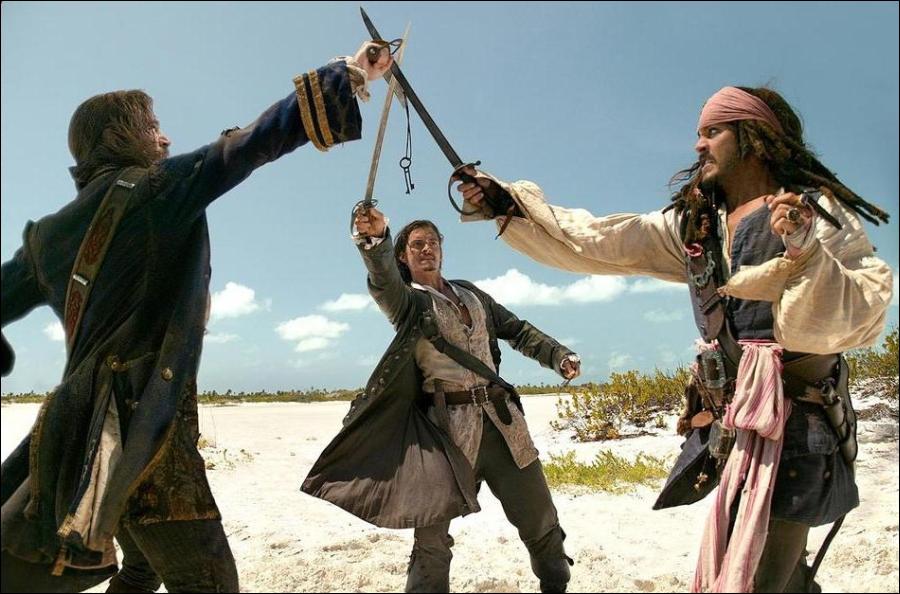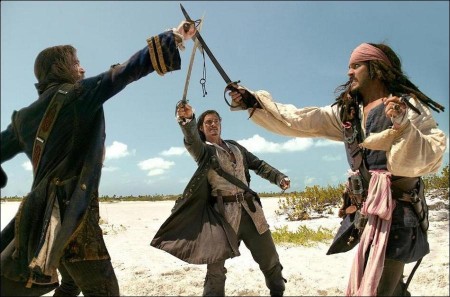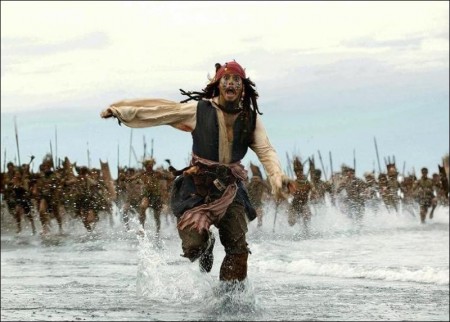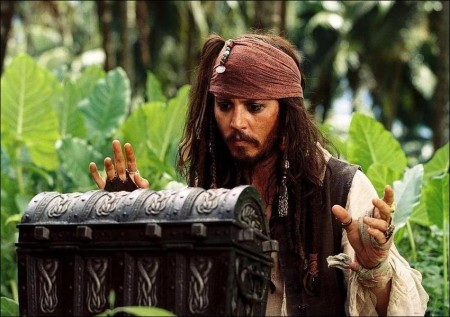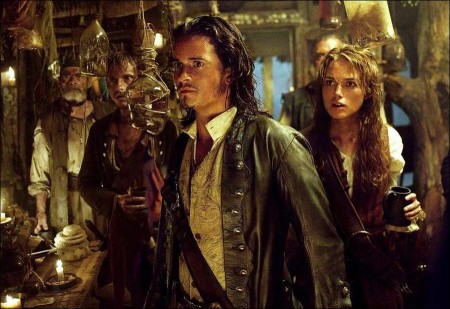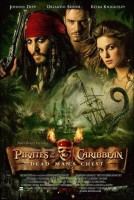This time around, Johnny returns as Captain Jack Sparrow and is caught in yet another tangled web of supernatural intrigue. It turns out, Captain Jack owes a blood debt to the legendary Davey Jones, ruler of the ocean depths and captain of the ghostly Flying Dutchman. If Jack can’t figure a crafty way out of this one, he’ll be cursed to an afterlife of eternal servitude and damnation. And as if that weren’t enough, Captain Jack’s problems throw a huge wrench into the wedding plans of the blissful Will Turner and Elizabeth Swann, thrust into Jack’s misadventures.
Johnny Depp, Orlando Bloom and Keira Knightley reunite in Walt Disney Pictures’, in association with Jerry Bruckheimer Films, Pirates of the Caribbean: Dead Man’s Chest, an all new epic tale chronicling the further mis-adventures of Captain Jack Sparrow.
Produced by Jerry Bruckheimer and directed by Gore Verbinski from a screenplay written by Ted Elliott & Terry Rossio, Captain Jack sets sail on an all new adventure – filled with more intrigue, more spectacular special effects and more comedy – in July 2006.
Captain Jack Sparrow (Johnny Depp) discovers he owes a blood debt to the legendary Davey Jones, Captain of the ghostly Flying Dutchman. With time running out, Jack must find a way out of his debt or else be doomed to eternal damnation and servitude in the afterlife. Making matters worse, Sparrow’s problems manage to interefere with the wedding plans of a certain Will Turner (Orlando Bloom) and Elizabeth Swann (Keira Knightley), who are forced to join Jack on yet another one of his misadventures.
About the Production
In art, as in life, history has a strange way of turning full circle. The first on-screen image ever to appear in an all live-action Walt Disney Studio feature was none other than a closeup of the skull and crossbones Jolly Roger flag in the classic 1950 version of Robert Louis Stevenson’s “Treasure Island.”
Some 53 years later, it took the very same studio’s “Pirates of the Caribbean: The Curse of the Black Pearl” to spectacularly re-invent and reinvigorate a moribund genre which once again is delighting millions. From childhood classics like Treasure Island and Howard Pyle’s Book of Pirates, to such classic films as “The Black Pirate,” “The Buccaneer” and “The Crimson Pirate,” the swashbuckling tales of high seas derring-do both nefarious and noble were seemingly neverending.
Alas, as far as filmmakers were concerned, pirates were forgotten as subjects worthy of contemporary moviemaking. It took Jerry Bruckheimer, Gore Verbinski and a brilliant company of actors and behind-the-scenes artists to breathe new life into the Jolly Roger’s sails, inspired by the great Disney Theme Parks attraction which has enchanted generations since its 1967 debut at Disneyland in Anaheim. The Pirates of the Caribbean attraction, which utilized the then brand-new technology of audio-animatronics which Walt Disney and his Imagineers magnificently developed, soon became a major part of pop culture, with its cheery refrains of “Yo ho yo ho, a pirate’s life for me” (and the less cheery warning that “Dead men tell no tales”) sung and quoted by millions.
Using the ride as a springboard, with clever references to the attraction’s content sprinkled throughout, “Pirates of the Caribbean: The Curse of the Black Pearl” was a smash hit everywhere it played, amassing a domestic U.S. gross of $305,413,918 million and, including its record-breaking overseas engagements, a worldwide total of $653,913,918. The film also received five Academy Award nominations, including Best Actor for Johnny Depp.
Like the ride itself, “Pirates of the Caribbean” appealed to the little bit of pirate that lives within us all, the desire for freedom, adventure and not a small amount of mischief. While paying affectionate homage to the cinematic adventures which preceded it, “Pirates of the Caribbean: The Curse of the Black Pearl” sailed into entirely new territory, breaking with tradition by linking its high seas tale with lashings of irreverent humor, as typified by Johnny Depp’s original and brilliantly inspired creation of Captain Jack Sparrow…a pirate the likes of which audiences had never seen before.
That success was never a sure thing, Bruckheimer now admits. “There were limited expectations for the first `Pirates.’ Lots of people thought we were making a Disney ride movie for toddlers, and what’s more, the pirate genre had been dead for 40 years, and every attempt to revive it had bombed miserably. But then `The Curse of the Black Pearl’ was released and caught everybody by surprise, which is the best way to do it. The artistry that Gore and the writers brought to it, and the performances by Johnny, Orlando, Keira and Geoffrey, just captured everybody’s imagination and it became a huge success internationally.
“Everything that we set up in the first movie gets pushed forward in the second,” Bruckheimer continues, “and of course we have the same creative team. Gore is such a brilliant director, with a wonderful sense of humor and a great visual sense.Often, strongly visual directors aren’t great storytellers because they focus so much on the physical look of the movie. But Gore has both the visual acumen and the understanding of storytelling and characterization.
“Johnny, Orlando and Keira are all back for the ride,” adds Bruckheimer, “plus some wonderful and interesting new faces. The Black Pearl will, of course, be back, along with a new mystery ship, the Flying Dutchman, which is crewed by a very exciting and unusual group of sailors under the command of Davy Jones.
“It all comes down to the imagination of the director, writers and the hundreds of people working on the movie,” says the producer. “Everybody’s excited about making an enormous piece of entertainment that audiences will love.”
“Pirates of the Caribbean: The Curse of the Black Pearl” not only revived the genre, but kicked off a groundswell of fascination for all things piratical which resulted in everything from a spate of new books about the seafaring scalawags, to a boom in pirates-themed children’s (and adult’s) parties, to pirate dinner shows, not to mention “I (Heart) Jack Sparrow” stickers plastered onto schoolgirls’ binders all over the world.
Clearly, there was a worldwide mandate for more “Pirates,” and Jerry Bruckheimer and Gore Verbinski, along with Walt Disney Pictures, decided that just one sequel would not be enough.It made practical sense, economically, to film two follow-ups simultaneously, taking full advantage of locations, sets and availability of its increasingly in-demand stars. It also made sense creatively, because with the characters so well established in the first film, taking them on further voyages was an exciting prospect. “We were hoping for the success of `The Curse of the Black Pearl’ so that we could make more `Pirates” movies,” notes Bruckheimer, “and when you see the second and third films you’ll see that everything relates back to what started everything off in the first. It’s a true trilogy.”
“You really need to have some substance behind it,” confirms executive producer Mike Stenson. “You need to not only deliver the entertainment value, the roller coaster ride and the laughs, but if you’re going to ask people to stay around for three movies, you have to feel like there’s something thematically significant that you’re going to explore.”
Says screenwriter Terry Rossio, “Whereas in the first film, the theme park attraction was a wellspring for ideas, for the second and third films we actually went back to the first movie.”
Adds Rossio’s writing partner Ted Elliott, “There was a richness to the characters that we felt we could explore, but you don’t want to just go through the same paces with the characters. You don’t want to see them doing the same thing. One of the things we liked about the characters in the first film was that there’s a certain moral ambiguity to them, and we wanted to explore that…we wanted to put Jack Sparrow into a situation where he has to do something that, in fact, puts his goals in opposition to Will and Elizabeth’s goals. It was all about expanding the characters and taking them in a further direction.”
“Similarly,” Rossio continues, “much of the basis of the first movie was the romantic story between Will and Elizabeth, and we knew we wanted to get into more of a mature examination of the relationship between the two of them. What happens to Will and Elizabeth after that wildly romantic final kiss with the beautiful sunset at the end of `The Curse of the Black Pearl’?”
“Dead Man’s Chest” also dips deeply into the treasure trove of pirate and seagoing lore and mythology, from Davy Jones, he of the famous “locker,” to the legendary Kraken, a sea monster fabled since the 12th century. “You think of the sea,” says Elliott, “and there are a lot of supernatural stories you’ve heard. But nobody had actually done those stories as part of a larger pirate movie or swashbuckler, so there was a wealth of legends to draw from. We touched on some of those in the first movie: there’s a line of dialogue in which Will talks about sending himself down to Davy Jones’ Locker. So in `Dead Man’s Chest,’ we decided to explore who Davy Jones is, and then we brought in another well known legend of the seas, the Flying Dutchman, and combined them together.”
Elliott and Rossio also cleverly utilized one of history’s greatest economic and political powers-the East India Trading Company-as a pivotal entity in the plot of “Dead Man’s Chest” Like much else in the “Pirates” movies, historical reality is used as a springboard for fun and fantasy. The real British East India Company was a tool of imperialist domination, economically and politically, from 1600 to its dissolution in 1858, essentially ruling India and spreading its tentacles as far as the Persian Gulf, Southeast Asia and East Asia. Even the most generous contemporary histories describe the East India Company’s activities as extraordinarily greedy and inhumane.
“What we like about pirates,” states Elliott, “is that they represent freedom. And the East India Company, as a giant multi-national corporation, represents the end of individual freedom. They’re defining the world as they want it to be, and there will be a lot of people they’re going to leave out. The more dominance they have, the less room there is for people like Captain Jack Sparrow.”
These production notes provided by Walt Disney Pictures.
Pirates of the Caribbean: Dead Man’s Chest
Starring: Johnny Depp, Orlando Bloom, Keira Knightley, Stellan Skarsgård, Bill Nighy, Jack Davenport, Kevin R. McNally, Jonathan Pryce
Directed by: Gore Verbinski
Screenplay by: Terry Rossio, Ted Elliot
Release Date: July 6th, 2006
MPAA Rating: PG-13 for intense sequences of adventure violence, including frightening images.
Studio: Walt Disney Pictures
Box Office Totals
Domestic: $423,315,812 (39.7%)
Foreign: $642,863,913 (60.3%)
Total: $1,066,179,725 (Worldwide)
